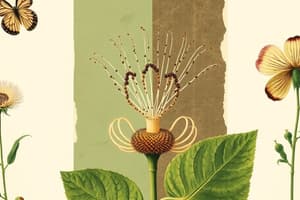Podcast
Questions and Answers
What structure in a flower produces ovules that generate egg cells?
What structure in a flower produces ovules that generate egg cells?
- Style
- Stamen
- Anther
- Ovary (correct)
How many carpels are fused in the pistil of an Arabidopsis flower?
How many carpels are fused in the pistil of an Arabidopsis flower?
- Three
- Four
- One
- Two (correct)
Which part of the male floral structure is responsible for producing pollen grains?
Which part of the male floral structure is responsible for producing pollen grains?
- Stamen
- Filament
- Anther (correct)
- Receptacle
What is the primary function of the stigma in a flower?
What is the primary function of the stigma in a flower?
Which part of the flower is made up of one or more carpels?
Which part of the flower is made up of one or more carpels?
Which part of the flower contains one or more ovules and can develop into a fruit?
Which part of the flower contains one or more ovules and can develop into a fruit?
What function do sepals primarily serve in a flower?
What function do sepals primarily serve in a flower?
What character is used to classify an ovary as superior or inferior?
What character is used to classify an ovary as superior or inferior?
What is the term for the stalk that supports the flower?
What is the term for the stalk that supports the flower?
Which of the following represents a type of inflorescence?
Which of the following represents a type of inflorescence?
In the context of Arabidopsis flowers, what does each pollen grain produce?
In the context of Arabidopsis flowers, what does each pollen grain produce?
What is the primary function of the leaf-like sepals in a flower?
What is the primary function of the leaf-like sepals in a flower?
Which flower structure is not involved in the reproductive process?
Which flower structure is not involved in the reproductive process?
What do both polar nuclei in an ovule participate in?
What do both polar nuclei in an ovule participate in?
Which of the following flowers has eight stamens as described?
Which of the following flowers has eight stamens as described?
What type of flower structure is referred to as a 'head' in the examples given?
What type of flower structure is referred to as a 'head' in the examples given?
What term refers to the collective arrangement of all the petals in a flower?
What term refers to the collective arrangement of all the petals in a flower?
What is the function of the anther in a flower's structure?
What is the function of the anther in a flower's structure?
In a flower, what structure typically bears the ovules?
In a flower, what structure typically bears the ovules?
What do pollen grains consist of at first?
What do pollen grains consist of at first?
What is required for sexual reproduction to occur in flowers?
What is required for sexual reproduction to occur in flowers?
How can carpels be classified in relation to each other?
How can carpels be classified in relation to each other?
What is the likely outcome if pollen does not reach the ovule?
What is the likely outcome if pollen does not reach the ovule?
What type of pistil is formed by a single carpel?
What type of pistil is formed by a single carpel?
Flashcards
Inflorescence
Inflorescence
Arrangement of flowers on a stem.
Sepals
Sepals
Leaf-like structures that protect the flower bud.
Stamen
Stamen
Male reproductive part of a flower.
Pistil
Pistil
Signup and view all the flashcards
Ovary
Ovary
Signup and view all the flashcards
Ovule
Ovule
Signup and view all the flashcards
Flower Structure
Flower Structure
Signup and view all the flashcards
Embryo Sac
Embryo Sac
Signup and view all the flashcards
Anther
Anther
Signup and view all the flashcards
Carpel
Carpel
Signup and view all the flashcards
Pollen grain
Pollen grain
Signup and view all the flashcards
Corolla
Corolla
Signup and view all the flashcards
Sexual reproduction in flowers
Sexual reproduction in flowers
Signup and view all the flashcards
Filament
Filament
Signup and view all the flashcards
Stigma
Stigma
Signup and view all the flashcards
Study Notes
Ragweed
- Ragweed (Ambrosia) contains numerous clusters of inconspicuous pollen-producing flowers at the tips of the spikes.
Reproductive Flexibility of Flowering Plants
- Flowering plants (angiosperms) include about 300,000 species. They reproduce both sexually and asexually.
- Flowers are adapted for sexual reproduction through varied colors, shapes, and fragrances to attract pollinators.
- Sexual reproduction involves the fusion of gametes (eggs and sperm cells) in the flower's ovary.
- Sexual reproduction results in genetically varied offspring, potentially better suited to the environment.
- Asexual reproduction produces offspring genetically identical to the parent plant, without flowers, seeds, or fruit.
- Offspring develop from vegetative parts like stems, leaves, or roots.
Flowers
- A flower is a reproductive shoot made up of four whorls of organs: sepals, petals, stamens, and carpels.
- Sepals protect the flower bud, often green.
- Petals attract pollinators, often colorful.
- Stamens produce pollen, with anthers containing pollen grains.
- Carpels contain ovules which develop into seeds.
- A complete flower has all four parts (sepals, petals, stamens, and carpels).
- An incomplete flower lacks one or more of these parts.
- A perfect flower has both stamens and carpels.
- An imperfect flower has either stamens or carpels, but not both (thus, an imperfect flower is also incomplete).
Pollination
- Pollination is the transfer of pollen grains (from the anther) to the stigma.
- Self-pollination occurs within the same flower, or a different flower on the same plant.
- Cross-pollination occurs between flowers on different plants of the same species.
- Animals (beetles, bees, flies, butterflies, moths) and wind can pollinate plants.
- Water pollinates some aquatic flowers.
Methods of Seed and Fruit Dispersal
- Wind
- Animals
- Water
- Explosive dehiscence
Seed Germination
- Seed germination requires water for activation of metabolic processes.
- Temperature, oxygen, and light are also environmental cues affecting germination.
Fruits
- Fruits are mature, ripened ovaries that protect seeds and sometimes aid in dispersal.
- Simple fruits develop from one or more fused carpels (e.g., berries, drupes)
- Aggregate fruits develop from multiple carpels in a single flower (e.g., raspberries, blackberries).
- Multiple fruits develop from multiple ovaries (and therefore multiple flowers) on a single stem (e.g., pineapples, figs).
- Accessory fruits are composed of both ovary tissue and other tissues, including floral parts (e.g., apples, pears).
Studying That Suits You
Use AI to generate personalized quizzes and flashcards to suit your learning preferences.





